House Sparrow (English Sparrow)
Passer domesticus
The house sparrow has been introduced all over the world
Advertisement
House Sparrow (English Sparrow) Scientific Classification
- Kingdom
- Animalia
- Phylum
- Chordata
- Class
- Aves
- Order
- Passeriformes
- Family
- Passeridae
- Genus
- Passer
- Scientific Name
- Passer domesticus
Read our Complete Guide to Classification of Animals.
House Sparrow (English Sparrow) Conservation Status
House Sparrow (English Sparrow) Locations

House Sparrow (English Sparrow) Facts
- Prey
- Insects, spiders, worms, and seeds
- Fun Fact
- The house sparrow has been introduced all over the world
- Estimated Population Size
- 900 million to 1.3 billion
- Biggest Threat
- Habitat loss
- Most Distinctive Feature
- The black eye stripe and bib on the male
- Other Name(s)
- English sparrow
- Wingspan
- 25cm (10in)
- Incubation Period
- 11 days
- Habitat
- Agricultural, residential, and urban areas
- Predators
- Hawks, falcons, owls, shrikes, cat, raccoons, and snakes
- Diet
- Omnivore
- Type
- Bird
- Common Name
- House Sparrow
- Number Of Species
- 1
- Location
- Worldwide
- Nesting Location
- Buildings and trees
- Age of Molting
- 2 weeks
- Migratory
- 1
View all of the House Sparrow (English Sparrow) images!
Clever, energetic, and highly social, the house sparrow is one of the most common birds in the world.
More than any other bird species, house sparrows share space with human habitats. Even in areas where they’re considered to be an invasive species, they often make for a common and pleasant sight. You can attract them to your yard with a simple nest box, clean water, and some seeds. This article will cover some interesting facts about the size, diet, and call of the house sparrow.
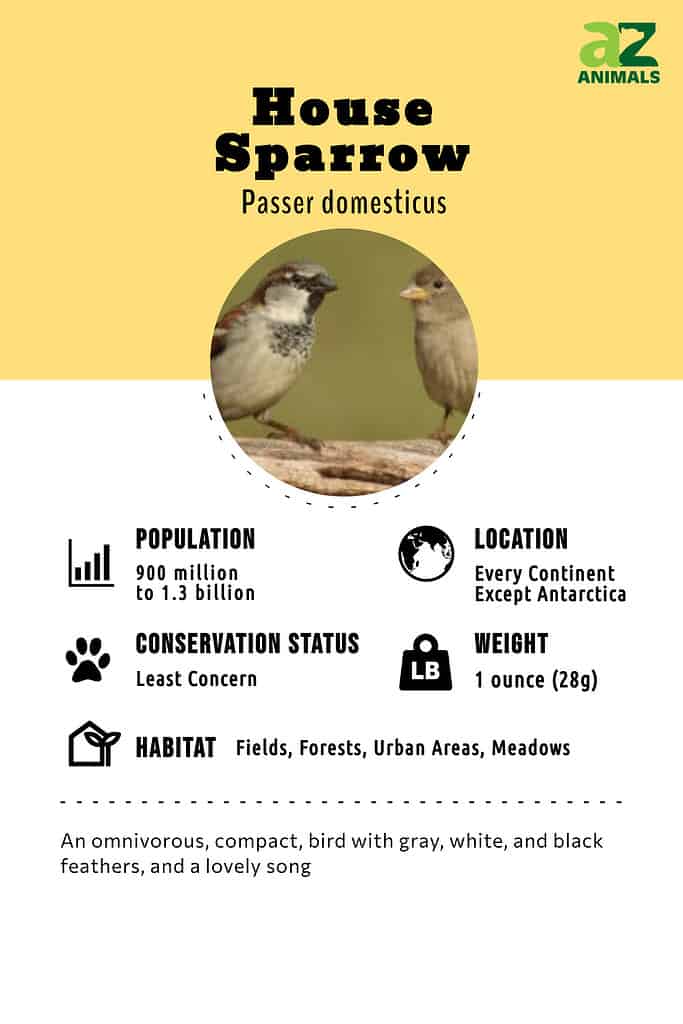
House Sparrow vs. House Finch
With its streaky black feathers and red-colored head, the house finch looks very little like a house sparrow. The main similarity is that they both like to reside near human habitats, but their appearance and behavior are completely different.
3 House Sparrow Amazing Facts
- House sparrows roost together in large communities, sometimes even with other species of birds. They sleep with their bill tucked beneath the wing.
- House sparrows fly by continuously flapping their wings in mostly a straight line. One of the most amazing facts is that they make about 15 wing beats per second.
- House sparrows will consume almost any kind of seeds, but they seem to prefer oats and wheat.
Habitat: Where to Find the Them
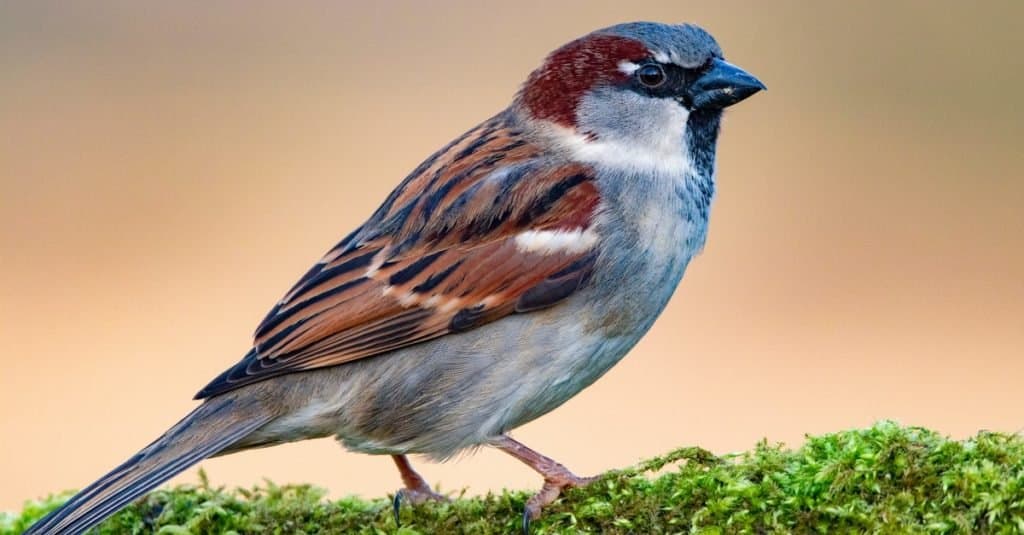
House sparrows live on every continent except Antarctica.
©Craig Howman/Shutterstock.com
The house sparrow is endemic to most of Eurasia and Northern Africa. They’ve also been accidentally or purposefully introduced to Australia, New Zealand, and the Americas as an invasive species. As the name suggests, the house sparrow is most commonly associated with modified human habitats, including agricultural, residential, and urban areas. It is less likely to be found in areas without a human presence.
House Sparrow Nests
House sparrows construct a nest from dried vegetation, feathers, strings, and paper in a small crevice. Buildings and trees are the most common nesting sites.
Scientific Name
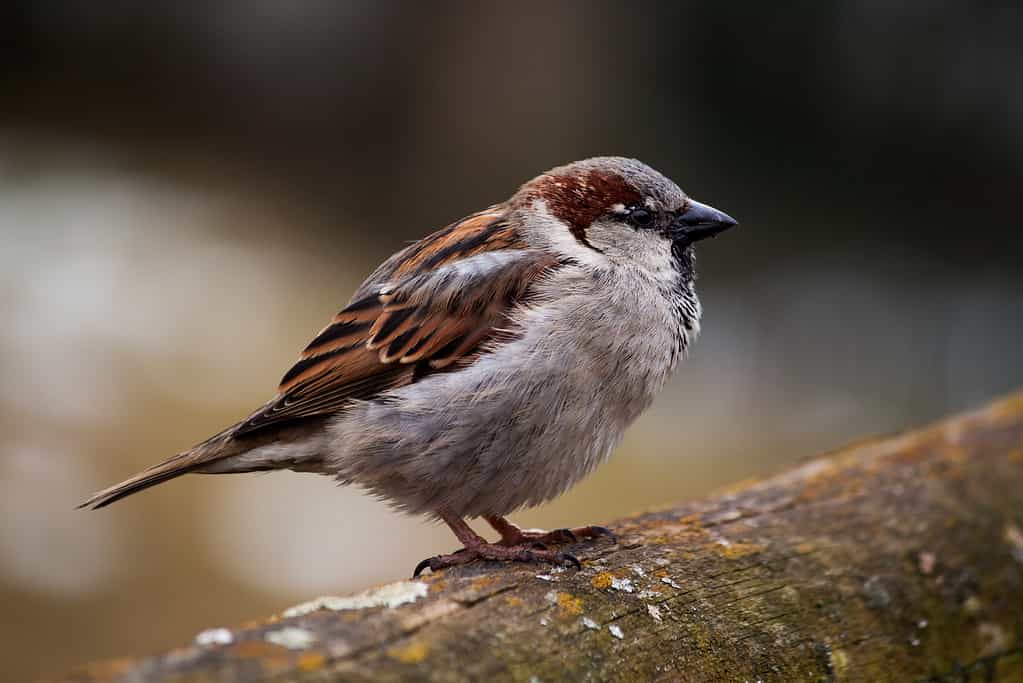
The scientific name for a house sparrow is Passer domesticus.
©iStock.com/Vronja_Photon
The scientific name of the house sparrow is Passer domesticus. Passer is the Latin term for sparrow, while domesticus is the Latin term for domesticated or belonging to the house. It is closely related to dozens of other sparrows within the same genus, including the Eurasian tree sparrow, great sparrow, and Italian sparrow.
Evolution and Origins
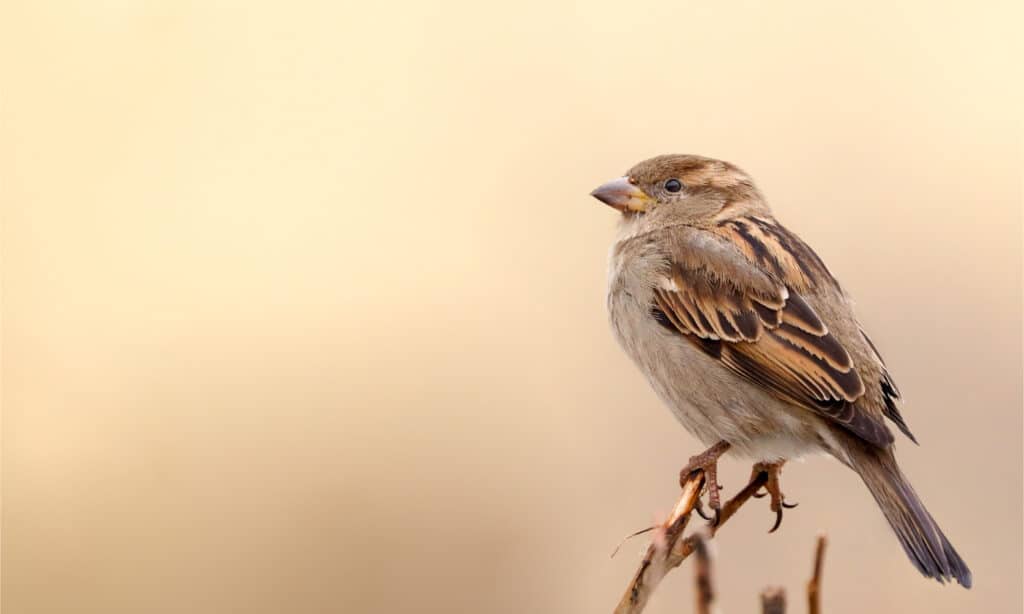
House sparrows originated in the Middle East 10 million years ago.
©fewerton/Shutterstock.com
The house sparrow, also known as Passer domesticus, is a small bird that has a long and complex evolutionary history. The origins of this species can be traced back to the Middle East, where it likely evolved from an ancestral group of sparrows over 10 million years ago.
Despite its widespread presence today, the house sparrow was not always so successful. In fact, during the last ice age (approximately 20,000 years ago), much of Europe was covered in glaciers, and the population of house sparrows declined dramatically. However, as temperatures began to warm up again and habitats became more favorable for these birds, their populations started to recover.
In terms of fossil evidence, there are relatively few specimens available for study due to the small size and delicate nature of these birds’ bones. Nevertheless, researchers have been able to identify several key features that distinguish modern-day house sparrows from their ancient ancestors.
For example, early forms of this species had shorter wings and smaller bodies than their contemporary counterparts. They also lacked many of the specialized adaptations that allow modern-day house sparrows to thrive in urban environments, such as increased tolerance for human disturbance or resistance towards pollutants.
Overall though, despite facing numerous challenges throughout its evolutionary history, including climate change and habitat loss, the house sparrow has managed to adapt effectively over time, thus becoming one of the most common bird species found across various regions worldwide today.
Size, Appearance, and Behavior
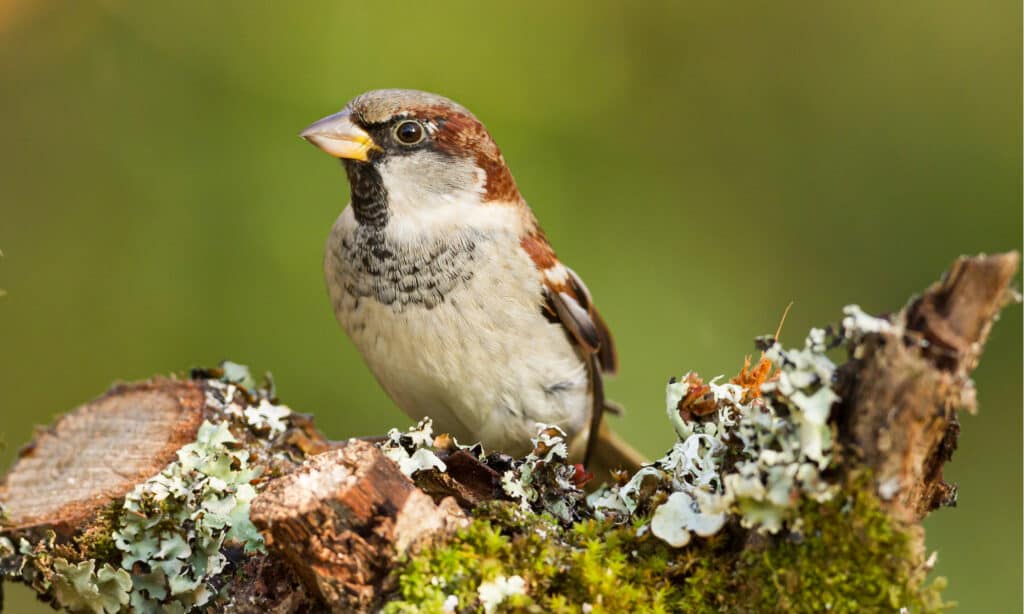
House sparrows have a wingspan of 10 inches and weigh only one ounce.
©PatP66/Shutterstock.com
The house sparrow is a small and stout bird measuring about 6 to 7 inches long from head to tail with a maximum wingspan of 10 inches. It is characterized by short legs, a thick bill, pale gray or buff plumage, and brown wings with black streaks. The sexes can be a little difficult to tell apart, but the male members usually have white cheeks and a black bib. Juveniles and baby sparrows tend to look like females, except the plumage is even paler.
House sparrows are highly territorial in defense of their nesting sites. We know that they defend nesting sites and not necessarily food resources because the sparrows will only attack members of the same sex. In the breeding season, males produce a simple trilling song to defend their territory and attract mates. It’s debatable whether this would qualify as a true song, however, because the call doesn’t have much rhythm. House sparrows of both sexes are also capable of making several different chirping calls to communicate with each other.
Migration Pattern and Timing
Most house sparrows remain very close to the place of their birth for their entire lives, but a few subspecies, in particular, do migrate toward warmer climates for the winter. They begin to put on weight when the winter arrives to prepare for the annual migration.
Diet
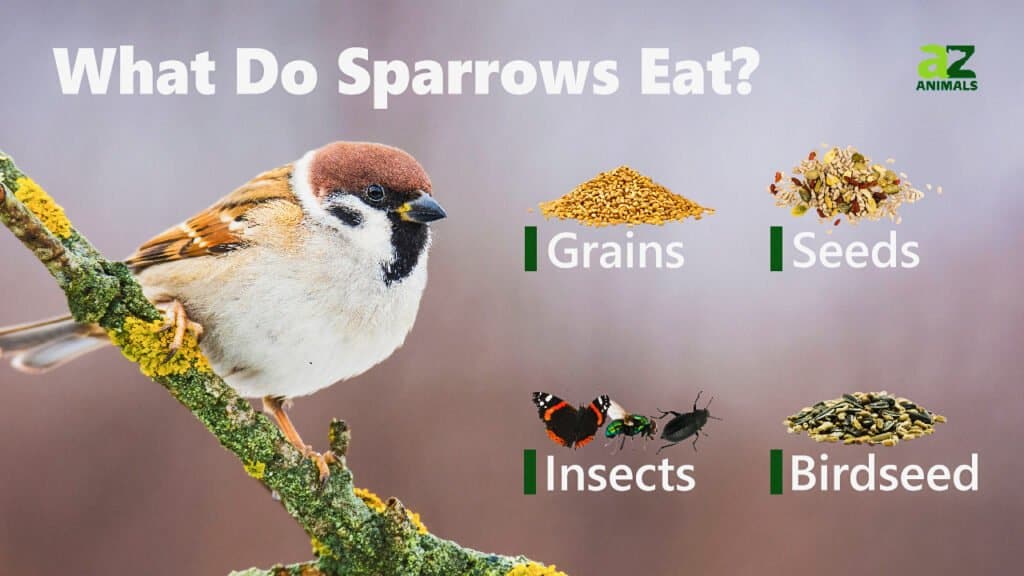
As one of the most common birds in North America, house sparrows have adapted to a variety of diets in order to survive. Their diet consists mainly of seeds and grains, but they also consume insects, fruits, and vegetables when available. In urban areas, they can often be found scavenging for food scraps or feasting on bird feeders.
House sparrows use a variety of methods to find their food. They have excellent eyesight and are able to spot small seeds and insects from great distances. They also rely heavily on their sense of hearing, which allows them to locate prey that may be hidden from view.
In addition to these senses, house sparrows also use their memory and problem-solving skills when searching for food. They will return repeatedly to places where they have found abundant sources of food in the past and will even learn how to open certain types of containers or packaging if it means getting access to tasty treats.
Despite their adaptability as omnivores with various hunting techniques at hand, house sparrow populations are under threat due largely in part because habitat loss brought upon by human activities such as development projects that destroy nesting sites or limit feeding grounds.
Predators, Threats, and Conservation Status

Humans are the biggest threat to house sparrows. They also have to watch out for housecats!
©iStock.com/Leoba
According to the IUCN Red List, the house sparrow is considered to be a species of least concern. It is not endangered at all, but population numbers have seen a dramatic decline over the years. Various theories have been put forward to explain this decline, including disease and a reduction in nesting sites, but no one knows the true reason.
What eats the house sparrow?
The house sparrow is preyed upon by numerous predator birds, including hawks, falcons, owls, and shrikes. Eggs and juveniles are vulnerable to domestic cats, raccoons, and snakes. House sparrows generally forage together in small flocks to keep an eye on potential predators. If threatened, they do have the ability to mob a predator and drive it away.
Reproduction, Young, and Molting
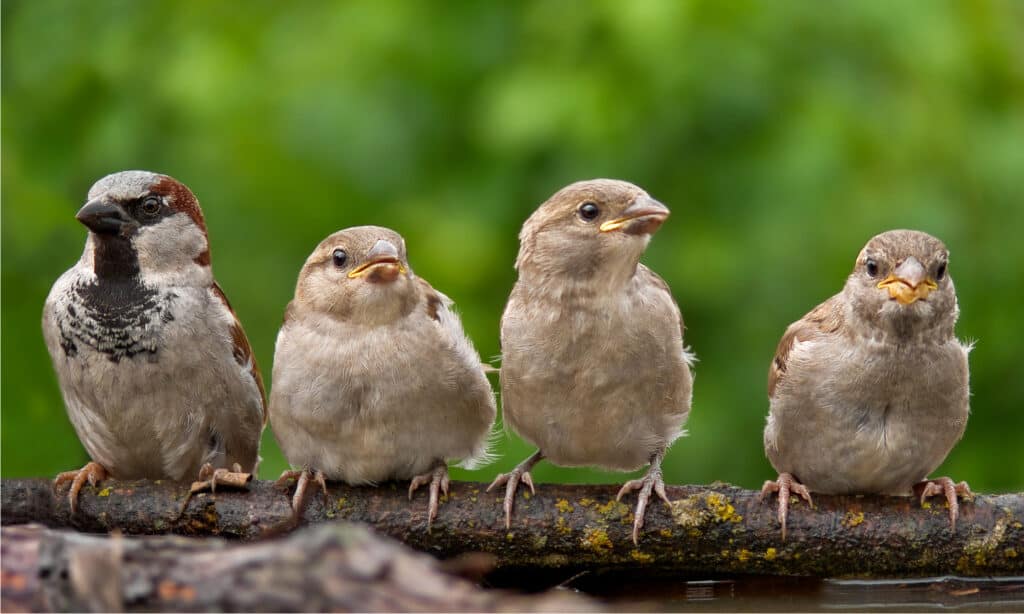
Fledgling sparrows are cared for, fed, and protected by both parents.
©Nick Vorobey/Shutterstock.com
The house sparrow’s reproductive season normally takes place in the spring and summer, depending on its location. They form monogamous pairs that last for the entire season. The male will produce his song to attract a mate. After mating, the female will lay up to eight eggs one at a time in the nest. Both the male and the female will incubate the eggs for anywhere between 10 and 14 days. They feed the baby chicks by regurgitating food directly into their mouths. It takes only two weeks for the baby chicks to gain their full-flight feathers and begin to leave the nest. A single pair can raise up to four clutches per breeding season. The maximum recorded lifespan of a wild house sparrow was 13 years old, but due to predation and disease, most will die after only a few years.
House Sparrow Population
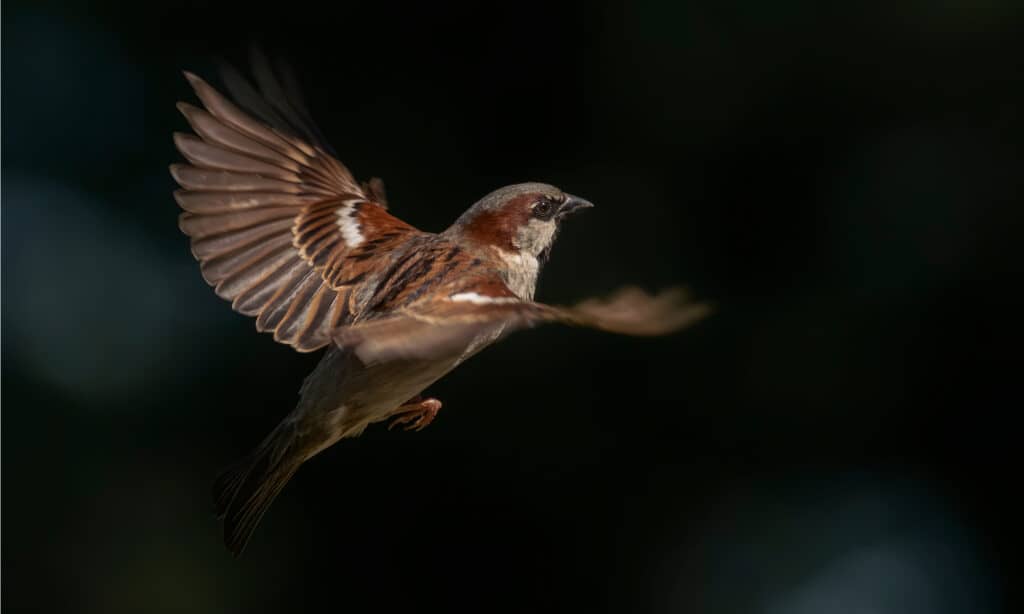
There are more than 900 million house sparrows on the planet.
©Albert Beukhof/Shutterstock.com
The house sparrow is estimated to have a total population of somewhere between 900 million and 1.3 billion mature individuals. It is one of the most widespread and reproductively successful birds in the world. Even though the house sparrow is not an endangered species, however, it might be endangered in some local areas around the world due to declining numbers.
View all 104 animals that start with HHouse Sparrow (English Sparrow) FAQs (Frequently Asked Questions)
Does the house sparrow migrate?
Only certain populations and subspecies migrate for the winter.
How many eggs does the house sparrow lay?
The female lays up to eight eggs per clutch and up to four clutches per year.
How fast does the house sparrow fly?
The house sparrow has a typical flight speed of around 28 miles per hour.
What is the house sparrow’s wingspan?
The house sparrow has a maximum wingspan of 10 inches.
When do house sparrows leave the nest?
The chicks leave the nest at around two weeks old.
Why are house sparrows a problem?
The house sparrow is often viewed as an invasive nuisance and pest outside of its native habitat because it spreads diseases and consumes agricultural products. On the other hand, it also has a beneficial role by controlling the population of other pests.
What is the difference between a house sparrow and a tree sparrow?
The tree sparrow is very difficult to distinguish from the house sparrow on account of their similar appearance and range. The main difference comes down to size: the tree sparrow is ever so slightly smaller on average than the house sparrow. They also have a chestnut-colored crown on the top of the head compared with the gray crown of the male house sparrow. Finally, they tend to inhabit woodlands and countrysides more often than human habitats.
Can a house sparrow be a pet?
Despite their close association with people, house sparrows are considered to be wild animals and need to be treated as such. While it may be possible to rear them from an early age to accept human care, they are rarely sold as pets.
Are house sparrows aggressive to humans?
House sparrows are not particularly aggressive unless they feel directly threatened.
What does a house sparrow look like?
The house sparrow is a small bird with a pale buff underside and brown-colored back and wings with black streaks. Males also have white cheeks and a black bib.
What are the differences between a song sparrow and a house sparrow?
Song sparrow vs. house sparrow – the song sparrow is insectivorous, nests in shrubs, and is a ground forager. The house sparrow is omnivorous, nests in cavities, and is also a ground forager.
Thank you for reading! Have some feedback for us? Contact the AZ Animals editorial team.
Sources
- (1970) rsity.org/accounts/Passer_domesticus/
- , Available here: https://scottishwildlifetrust.org.uk/2018/07/house-sparrow-tree-sparrow/
- , Available here: https://www.iucnredlist.org/species/103818789/155522130
















